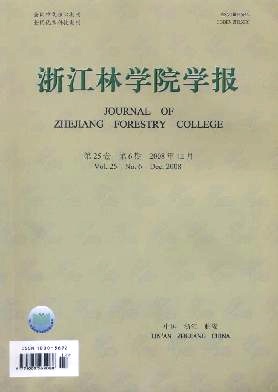Community characteristics of a Pinus tabulaeformis secondary forest and a planted forest in the Xunyangba Region of the Qinling Mountains
- Publish Date: 2008-12-20
-
Key words:
- forest ecology /
- Qinling Mountains /
- Pinus tabulaeformis /
- plantation /
- natural secondary forest /
- community characteristics /
- species diversity
Abstract: Based on the survey and data from 8 plots,the community characteristics of a natural secondary forest of Pinus tabulaeformis and P. tabulaeformis plantation were compared using a standard quadrat method,in order to know influence of different management style on restoration of the communities after disafforest about 40 years. Analyses included use of the similarity,Shannon-Wiener,Margalef,Richness,Simpson’s Dominance,and Evenness Indices. Main results as follow:(1)The secondary forest consisted of 134 vascular species belonging to 66 families and 104 genera,whereas the planted forest included 125 vascular species in 73 families and 104 genera. The families which included 1 to 2 species were plentiful in the two communities. A similarity index of 53.0% was obtained with 70 co-occurring species. (2)The vertical structure of both communities contained tree,shrub,and herb layers,with the tree layer subdivided into three layers. Plant density in the tree and shrub layers of the plantation was lower than the secondary forest(P<0.05),but density in the herb layer was higher(P<0.05). (3)From the angle of spatial patterns,in both secondary forest and plantation,the Shannon-Wiener,Margalef,and Richness Indices were in the order shrub > herb > tree,and Simpson’s Dominance Indices were tree > herb > shrub. However,differences were found with the Evenness Index for the secondary forest(shrub > herb > tree)versus the plantation(shrub > tree > herb). Also,compared to the plantation,in the secondary forest the Margalef and Richness Indices of the tree layer were higher(P<0.05),but the Evenness Index was lower(P<0.05). Additionally,in the plantation,Simpson’s Dominance Index for the herb layer was higher than in the secondary forest(P<0.05). (4)Litter layer in plantation was thicker than that in natural secondary forest(P<0.05). Thus,after 40 years of restoration,there were many community attribute similarities between plantations and secondary forests meaning that P. tabulaeformis was suitable for afforestation at this site. [Ch,9 tab. 21 ref.]
| Citation: | JING Li, ZHU Zhi-hong, WANG Xiao-an, et al. Community characteristics of a Pinus tabulaeformis secondary forest and a planted forest in the Xunyangba Region of the Qinling Mountains[J]. Journal of Zhejiang A&F University, 2008, 25(6): 711-717. |









 DownLoad:
DownLoad: